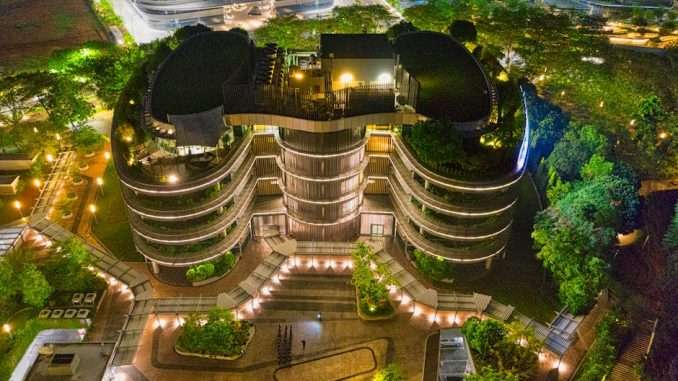
As the global community contends with the urgent challenge of climate change, increasing scrutiny is being placed on the construction industry—a sector significantly contributing to the problem while holding substantial promise for the solution. The United Nations Environment Programme’s 2022 Global Status Report highlights that the building and construction sector is responsible for an alarming 40% of energy-related CO2 emissions. Despite this, the industry has not met critical decarbonisation targets, with CO2 emissions from buildings reaching unprecedented levels. Nevertheless, the advent of sustainable building practices offers a promising path forward. By embracing sustainability, the construction industry can play a crucial role in addressing climate change and fostering a healthier, more resilient future.
Sustainable spaces are meticulously designed with environmental considerations at the forefront, prioritising energy efficiency, resource conservation, and a minimal ecological footprint. Frameworks such as LEED (Leadership in Energy and Environmental Design) and BREEAM (Building Research Establishment Environmental Assessment Method) provide comprehensive guidelines for reducing the environmental impact of construction projects. These certifications advocate for the use of sustainable materials, energy-efficient systems, and innovative design strategies that enhance the well-being of both the planet and building occupants.
A cornerstone of sustainable construction is energy efficiency. Buildings designed with sustainability in mind aim to minimise energy consumption through various approaches, including enhanced insulation, high-performance windows, and energy-efficient heating, ventilation, and air conditioning (HVAC) systems. Moreover, the integration of renewable energy sources—such as solar panels and wind turbines—into building designs further diminishes dependence on fossil fuels. The selection of construction materials is also critical, with a focus on responsibly sourced materials that reduce environmental impact throughout their life cycle. This encompasses considerations of resource extraction, manufacturing processes, transportation, and eventual disposal or recycling.
Indoor air quality and occupant health are paramount in sustainable building design. Sustainable buildings favour non-toxic, low-emission materials and incorporate advanced ventilation systems to maintain a healthy indoor environment. Water conservation is another essential aspect, with sustainable buildings often featuring efficient plumbing fixtures, rainwater harvesting systems, and greywater reuse. Innovative design elements such as green roofs and living walls are becoming more prevalent in sustainable architecture, enhancing the aesthetic appeal of buildings while contributing to energy efficiency, improved air quality, and stormwater management.
Sustainable buildings frequently employ passive design strategies, leveraging natural elements to maintain comfortable indoor conditions with minimal energy use. This includes optimising building orientation for natural light, utilising thermal mass to regulate temperature, and designing for natural ventilation. Net-zero energy buildings represent the zenith of sustainable design, generating as much energy as they consume over a year. Achieving net-zero energy necessitates a combination of energy-efficient designs, renewable energy generation, and sometimes energy storage systems. These buildings exemplify what is achievable when sustainability is prioritised from the outset.
The transition to sustainable spaces mandates a comprehensive, industry-wide commitment. Collaboration among stakeholders—including architects, engineers, developers, policymakers, and building occupants—is vital for advancing sustainable construction practices. The global demand for sustainable spaces is on the rise, driven by increasing public awareness of environmental stewardship and the long-term benefits of sustainable living. Sustainable building practices can yield significant cost savings over the life of a building. Energy-efficient systems and renewable energy sources reduce utility costs, while durable, low-maintenance materials lower repair and replacement expenses. Additionally, sustainable buildings often command higher property values and attract tenants willing to pay a premium for environmentally responsible spaces.
As sustainable building technologies evolve, they inspire innovation and creativity in design. Sustainable architecture seeks to harmoniously integrate nature and the built environment, creating spaces that are both functional and visually appealing. Green building standards and sustainable building codes are becoming more prevalent, providing clear guidelines for sustainable construction projects. These regulations help ensure that new buildings meet high environmental performance standards, contributing to a more sustainable built environment. Reducing the carbon footprint of buildings is a primary objective of sustainable construction. By considering the entire life cycle of a structure—from design and construction to operation and eventual demolition—sustainable building practices aim to minimise environmental impact at every stage.
The journey towards sustainable spaces requires a concerted effort from all stakeholders in the construction industry. Collaboration among architects, engineers, builders, developers, policymakers, and occupants is crucial for advancing sustainable construction. This collaborative approach ensures that sustainability is integrated into every aspect of the building process, from initial concept to final occupancy. Embracing sustainability in construction is paramount for a greener future. Sustainable buildings contribute to a more resilient and sustainable future by reducing carbon emissions, conserving resources, and creating healthier environments for occupants. Moreover, sustainable building practices can lead to cost savings in the long run, making them economically viable as well as environmentally responsible.
Sustainable spaces offer long-term benefits for both the environment and society. They signify a commitment to creating a better world for future generations by addressing one of the most pressing issues of our time—climate change. As the construction industry continues to evolve, the commitment to sustainability must remain unwavering. By prioritising sustainable building practices, we can ensure our built environment positively impacts the planet, inspiring innovation and creativity in design. The journey from compliance to commitment in sustainable construction is vital. It necessitates a paradigm shift in how we design, build, and operate our spaces. By embracing sustainable practices, the construction industry can play a pivotal role in combating climate change and creating a more sustainable and resilient future for all. Sustainable building practices are not merely an option—they are a necessity. By committing to sustainable construction, we can mitigate the impacts of climate change, create healthier living environments, and pave the way for a more sustainable future. The journey towards sustainable spaces requires dedication, innovation, and collaboration, but the rewards—a healthier planet and a brighter future—are well worth the effort.


Be the first to comment